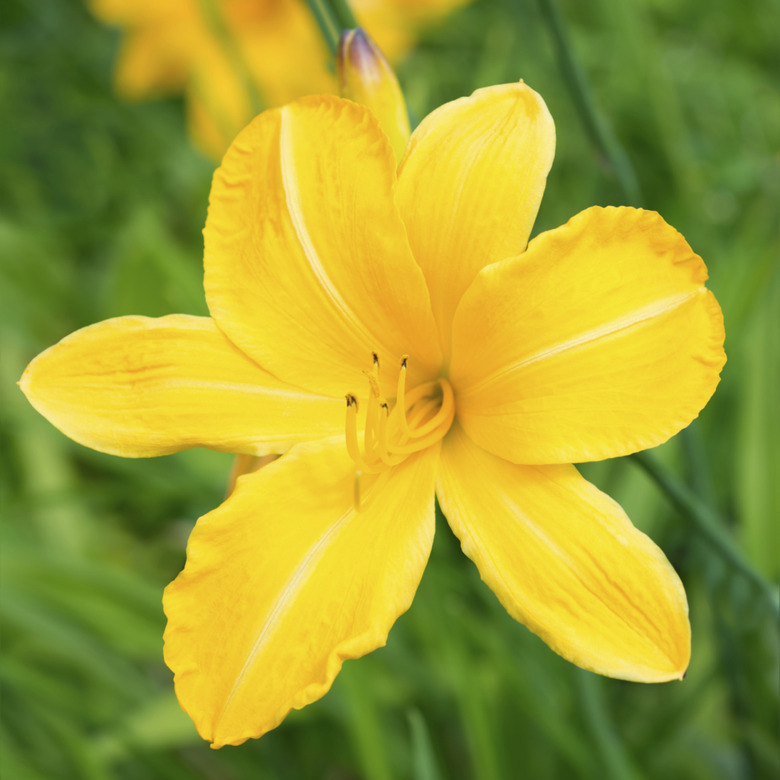Care Of Stella De Oro Daylilies Plants
A name translating to "Star of Gold" says it all: The "Stella de Oro" daylily (_Hemerocallis "Stella de Oro"_) has gilded enough gardens for enough years with enough ruffled, golden trumpet flowers to have earned botanical superstar status.
A name translating to "Star of Gold" says it all: The "Stella de Oro" daylily (Hemerocallis "Stella de Oro") has gilded enough gardens for enough years with enough ruffled, golden trumpet flowers to have earned botanical superstar status. At just 1 foot tall, the miniature daylily handles whatever the climates in U.S. Department of Agriculture plant hardiness zones 3 through 10 can throw its way, and comes back each spring for more. Whether a small-garden centerpiece or a large-space groundcover, "Stella de Oro" is the poster child for easy-care plants.
Fertilizing for Flowers
The ideal daylily soil is mildly acidic, moist and organically rich. With **two annual doses of fertilizer,** however, "Stella de Oro" feels right at home even in less-than-ideal soil.
Choose a slow-release, granulated fertilizer lower in nitrogen — the "N" number on the label — than in phosphorous and potash, the "P" and "K" numbers. **A 5-10-10 formula works well.** Too much nitrogen stimulates leaf growth at the expense of flowers.
Fertilize when new growth emerges in spring and after the first round of flowers fades. In hot-summer climates, delay the second application until temperatures drop in the fall. Sprinkle 3 1/3 tablespoons of the granules over each 10 square feet of soil and water them in.
Different fertilizer strengths require different application rates, so always follow the brand's label instructions.
Watering Well
Even though "Stella de Oro" tolerates drought, it grows more rapidly and blooms more freely with regular watering. As a general rule, 1 inch of rain or supplemental watering each week during the growing season is enough.
One inch of water amounts to about 6 gallons per 10 square feet of soil. More is not better, so tracking weekly rainfall with a rain gauge prevents overwatering.
Monitor the amount of rain in the gauge weekly during wet weather. When it registers less than 1 inch, water enough to make up the difference. For example, if the gauge holds 1/2 inch of rain, give "Stella de Oro" 3 gallons per 10 square feet of soil. Soak the ground slowly and deeply so the water reaches the roots.
Trimming for Tidiness
Even naturally neat "Stella de Oro" benefits from periodical grooming. Start in late winter by clearing out all the decaying or damaged leaves left from the previous season.
Promptly trim dead flowers to encourage new ones. Cut individual scapes — the flower stalks — off slightly above the soil when their last blooms have faded. Pull up leaves as they begin dying back in fall.
- Monitor the amount of rain in the gauge weekly during wet weather.
- Promptly trim dead flowers to encourage new ones**.
- Cut individual scapes — the flower stalks — off slightly above the soil when their last blooms have faded.
To avoid spreading disease, remove flowers or scapes with clean, sharp stem cutters disinfected in rubbing alcohol between cuts.
Dealing With Disease
Insects and disease seldom trouble "Stella deOro." An exception is the daylily rust fungus (Puccinia hemerocallidis). Daylily rust surfaces as yellow streaks and water-soaked, yellow spots on the upper leaf surfaces, followed by raised pustules of powdery, reddish-orange spores on the lower ones.
Winter cold in USDA zones 6 and lower kills rust on previously infected plants, but in warmer areas it comes back each year until temperatures above 97 degrees Fahrenheit slow its progress. Although unsightly, rust is never fatal and doesn't blemish the flowers.
Control a rust outbreak by removing affected plants and disposing of them in sealed plastic bags. Keep healthy plants 1 1/2 to 2 feet apart for good air circulation, and water them from beneath so their leaves remain dry.
- To avoid spreading disease, remove flowers or scapes with clean, sharp stem cutters disinfected in rubbing alcohol between cuts.
- Keep healthy plants 1 1/2 to 2 feet apart for good air circulation, and water them from beneath so their leaves remain dry.
